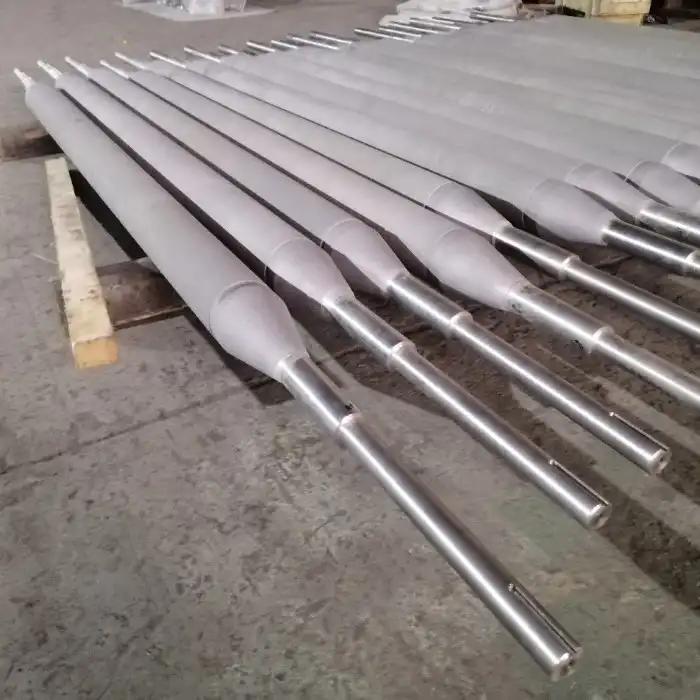Understanding the Crucial Role of Furnace Rolls in Production Processes
The Function of Furnace Rolls in High-Temperature Operations
Furnace rolls are indispensable components in various industrial processes that involve high-temperature operations. These rolls are designed to withstand extreme heat while supporting and transporting materials through furnaces. In steel mills, for example, furnace rolls are used in continuous annealing lines and galvanizing processes, where they guide steel strips through heating and cooling zones. The rolls must maintain their structural integrity and surface quality under intense thermal stress to ensure the consistent treatment of the materials passing over them.
Material Composition and Design Considerations for Furnace Rolls
The effectiveness of furnace rolls largely depends on their material composition and design. Manufacturers often use heat-resistant alloys such as stainless steel, nickel-based superalloys, or ceramic materials to construct these rolls. The choice of material is critical as it must withstand not only high temperatures but also potential chemical reactions with the materials being processed. Additionally, the design of furnace rolls incorporates features like internal cooling systems and specialized surface treatments to enhance their performance and longevity in harsh operating environments.
The Importance of Furnace Rolls in Maintaining Product Quality
The condition of furnace rolls directly influences the quality of the final product. Well-maintained rolls ensure uniform heat distribution and consistent material handling, which are essential for achieving the desired material properties and surface finish. In industries such as automotive and aerospace, where precision and quality are paramount, the role of furnace rolls in maintaining tight tolerances and surface characteristics cannot be overstated. Any imperfections or irregularities in the rolls can lead to defects in the processed materials, potentially resulting in costly rejections or rework.
Consequences of Inadequate Furnace Roll Maintenance
Reduced Production Efficiency and Increased Downtime
One of the most immediate impacts of poorly maintained furnace rolls is a significant reduction in production efficiency. As the rolls deteriorate, they may cause uneven heating or cooling of materials, leading to inconsistencies in the production process. This can result in slower production speeds as operators attempt to compensate for these irregularities. Moreover, when furnace rolls fail or require emergency maintenance, it often necessitates unplanned shutdowns. These unexpected periods of downtime not only disrupt production schedules but also incur substantial costs in terms of lost productivity and potential breach of delivery commitments to customers.
Compromised Product Quality and Increased Reject Rates
Poorly maintained furnace rolls can severely compromise the quality of the final product. Worn or damaged rolls may cause surface defects such as scratches, dents, or uneven thickness in the processed materials. In industries where surface finish is critical, such as in the production of automotive body panels or high-grade steel for construction, these imperfections can lead to high reject rates. The increased number of defective products not only wastes raw materials but also requires additional time and resources for rework or disposal, further impacting the overall production efficiency and profitability.
Accelerated Wear and Tear on Related Equipment
The impact of inadequate furnace roll maintenance extends beyond the rolls themselves. Damaged or misaligned rolls can cause increased stress on related equipment such as bearings, drive systems, and adjacent components. This accelerated wear and tear can lead to a domino effect of equipment failures, potentially causing more extensive and costly breakdowns throughout the production line. Additionally, the uneven operation of poorly maintained rolls can result in increased vibration and noise, which may contribute to premature fatigue of surrounding structures and create a less safe working environment for operators.
Strategies for Effective Furnace Roll Maintenance and Optimization
Implementing Regular Inspection and Preventive Maintenance Schedules
To mitigate the impacts of poorly maintained furnace rolls, implementing a robust inspection and preventive maintenance schedule is crucial. This should include regular visual inspections for signs of wear, damage, or misalignment. Non-destructive testing techniques such as ultrasonic testing or eddy current inspection can be employed to detect internal defects or material degradation. Establishing a systematic approach to maintenance, with clearly defined intervals and procedures, helps prevent unexpected failures and extends the service life of furnace rolls. It's also important to maintain detailed records of inspections and maintenance activities to identify patterns and optimize maintenance schedules over time.
Utilizing Advanced Monitoring Technologies for Predictive Maintenance
Embracing advanced monitoring technologies can significantly enhance furnace roll maintenance strategies. Sensor-based systems can continuously monitor parameters such as temperature, vibration, and surface condition of the rolls during operation. This real-time data can be analyzed using predictive maintenance algorithms to forecast potential failures before they occur. By leveraging these technologies, maintenance teams can transition from reactive to proactive maintenance approaches, scheduling interventions at optimal times to minimize disruption to production while maximizing the lifespan of the furnace rolls.
Investing in High-Quality Replacement Parts and Upgrade Options
When replacement or upgrades are necessary, investing in high-quality furnace rolls and related components is essential for long-term production efficiency. Working with reputable suppliers who specialize in furnace roll manufacturing ensures access to parts that meet or exceed original equipment specifications. Consider exploring upgrade options that incorporate the latest advancements in materials science and roll design. These may include improved alloys with enhanced heat resistance or innovative surface treatments that reduce wear and extend service intervals. While the initial investment may be higher, the long-term benefits in terms of reduced maintenance costs and improved production quality often justify the expense.
In conclusion, the impacts of poorly maintained furnace rolls on production can be severe and far-reaching. From reduced efficiency and product quality to increased downtime and equipment wear, the consequences underscore the critical importance of proper maintenance and timely upgrades. By implementing comprehensive maintenance strategies, leveraging advanced technologies, and investing in quality components, industries can significantly mitigate these risks and optimize their production processes. For expert guidance on furnace roll selection, maintenance, and customization to meet your specific industrial needs, please contact us at info@welongpost.com. Our team of experienced engineers and technicians is ready to assist you in enhancing your production efficiency and product quality through superior furnace roll management.
References
- Plasma Spray Coating: Process and Applications - MFG Shop. (2025, January 6).
- Key Materials for Extreme High-Temperature Environments: Ultra-High-Temperature Ceramics and Their Composites. (2025, January 22). ScienceDirect.
- Materials Science and Engineering: A. (2025, January 18). ivysci.com.
- Mechanical, Structural, Electronic, Magnetic, and Thermomagnetic Properties of Fe2MnAs1−xSix Alloys. (2025, February 12). Nature Scientific Reports.
- Guide for authors - Intermetallics. (2025, February 1). ScienceDirect.
- Surface and Coatings Technology. (2025, February 10). ScienceDirect.




